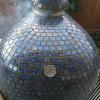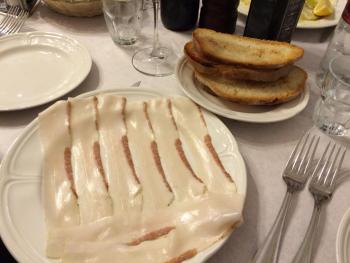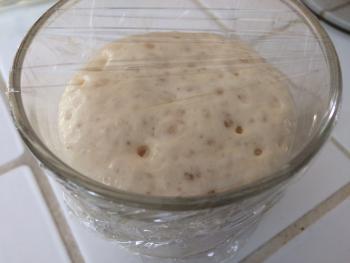-
Posts
840 -
Joined
-
Last visited
-
Days Won
8
Content Type
Profiles
Forums
Events
Everything posted by dstr8
-
^ glad its not dinner time here Sumptuous looking fare there Tony!
-
Although certainly edible baked at 500*F Neapolitan dough gets its renown at 750*F and north. You will find, if the classic chewy bubbled/blistered perimeter with medium to large air bubble interior (crust perimeter) is the goal, you will only get this quality at the higher temps. Lower temps result in a flatter crust without the development of fast rising air bubbles. The chew texture will be more homogenous; whereas classic Neapolitan will have the thin, chewy layer on the outside portion of the crust yet light and forgiving interior. For pre-heating my KK: Ideally I start a smaller fire, using the full size basket, about 90-minutes out from bake time with the stone in place. I get the KK & stone heat soaked at ~500*F or so. Then about 20-30 minutes from when I want it to be idling at 750*F (dome) I load the basket with lump.
-
Just for you EGGARY: A quick vid of my BIL stretching his Neapolitan dough tonight... https://www.dropbox.com/s/mfsbpg0fg50c615/Neapolitan%20dough%20stretch.mov?dl=0 Dan Edit: BTW the 3-containers of dough, one container per pie's worth and after about 48-hours cold ferment, were pulled from the refrigerator 1-hour from when he worked the dough in the video. The dough was still very cool to the touch yet stretched beautifully without tearing. My BIL has a Blackstone pizza oven and put any and all sneering by me...to bed after eating the first pie . The Blackstone, although lacking the wood flavor from a lump fired vessel, is quicker (ready to go in about 15-20 minutes!) and easier for pizza bakes at any temperature!
-
Rant: This is IMHO the biggest reason we can't buy real lard anymore. In relative terms real lard (not the shit in the plastic tubs in the mex aisle) is healthier than butter. But the same people that push lard aside glob butter on everything. Clueless. One of the many treats for me on my first trip to Italy last fall was enjoying lardo...splendido! For those of you that have not read any of Michael Pollan's books...I recommend each and all: http://michaelpollan.com Rant over
-
^ what temp did you bake the pies? Good idea tinyfish about the rice flour...presumably it has a higher smoking point and/or wouldn't turn bitter like wheat flour does on the bottom of Neapolitan pies (I use rice flour for my fish and chips batter...crazy good). Although I generally don't have sticky pizza peel issues anymore I have been tempted to buy one of these: http://brickovenbaker.com/brick-oven-and-baking-tools/peels/13-inch-rectangular-perforated-pizza-peel-47-inch-handle?gclid=CKexl-DClcUCFYZffgodiZwAVA
-
skreef: Good looking vittles! Just got back from my first visit to North Carolina...and had my first taste of the local fare, shrimp and grits, at the Spouter Inn dinner house in Beaufort...splendido! It was one of those depressing dinners. Depressing because with each fork full I got closer to the end of some incredibly tasty fare!
-
Good way & plan, CC, to forget about the roti
-
^ same question here. I just moved our 23" KK and used plywood in leapfrog fashion and it worked great including a section of downslope over gravel/rock... Getting it up the moving truck ramp took a little more creativity...
-
Hankvon: I don't know where you are located but Caputo 00 and other brands of flour can be sourced from Amazon.com and eBay. Altough its getting a little easier to find these flours I rely upon the aforementioned to source mine. Also, although I haven't tried it, King Arthur has a finer 00 grade pizza flour... FWIW: The typical flour most Italian's use for Neapolitan pies, including Caputo, has a lower protein content than KA's bread flour...
-
Its been awhile since I ordered my One Grill roti and motor but I ordered it for my KK and it fit, both sides, without issue...no force fitment required. However I did have to get creative with spacer washers on the KK bracket side as the motor and shaft did not sit in alignment with the KK receptacle/rotating bushing.
- 25 replies
-
- 1
-

-
Also if you opt to do a cold ferment you will only need a total of 1 gram of dry (non-instant!) yeast! I suggest, especially if you have a day or two for a cold ferment you use Jeff's recipe. Its just so reliable! Plus with a cold ferment you could actually leave it in the fridge for several days and up to 6 or so without too much penalty. Having said that I generally prefer the yeast activity and dough bloom in the bake-off with a 1-3 day cold ferment. Longer than this and I am not able to get the same texture to the finished/cooked dough with the bubble lattice I prefer. Mind you even at 5-6 days cold ferment the dough is still wonderful. But as I said you will find Neapolitan dough to be less than tolerant of big changes/mistakes. I can only relay I was super intimidated by the whole Neapolitan dough thing. But after you make a couple dozen pies and pay special attention to your hydration level (take notes and be consistent) you will relax and be out of newbie-ville. Its just going to take some practice...that's all. Also: When the dough is still in the individual containers but proofed and ready to pop out onto your bench: Dust the top of the dough ball with bench flour before you try to remove it from the container. Then, using a small silicone spatula, work your way around the perimeter of the dough ball working a little of the bench flour atop the dough ball between the container and the dough ball. Then turn the container upside down and coax, again using the silicone spatula, the dough ball onto an 1/4" or so deep layer of bench flour atop your bench (marble, metal or wood...but NOT grouted tile surface). Then dust your palms/hands with bench flour and gently start stretching the wet dough. You will learn to add minimal bench flour to the dough...just enough to prevent it from being terribly sticky. If the dough springs back unduly as you try to stretch it then just let the dough sit on the bench for a couple minutes of resting. And if you add too much bench flour you will create a dough that is too stiff...resulting in more of a cracker style crust rather than a moist airy dough that has a chewy but tender skin with large bubbles within. Practice, practice, practice. And ask more questions!
-
EGGARY, Looks like a classic Neapolitan dough recipe. Always, per the recipe, use a scale to weigh your ingredients and NEVER by volume. And I, like the recipe's author, never add any type of oil to my Neapolitan style dough. For the vessel(s) you will use to proof the dough literally place just one drop of olive/light oil in the container bowl and wipe/smear it with a towel. You just want the thinnest of oil films on the container to aid in dough removal after its proofed. You will find a cold ferment, usually a day or two (or longer sometimes) will bring more depth of flavor to the dough. Otherwise the short proof above will yield good results if milder in flavor. And unless you have played with soft wet pizza dough I'd recommend NOT making these pies for company until you have a dozen or more under your belt. The first few times you handle the dough will, more than likely, yield frustration. But experience is key here and you will find 55-65% hydration eventually will be a snap to deal with. There are just so many little things that make a big difference with Neapolitan style dough & pizzas. The margin for error is very narrow especially compared to Chicago and New York style doughs/pies. Once the dough is stretched on your bench be sure to work quickly. Leaving ingredients atop the dough will exacerbate getting the assembled pie moved to a peel and then slid off without disaster to your hot stone. My advice: Do not build the pizza atop the peel but rather build the pie on a marble, metal or even lightly dusted large cutting board surface then pull the pie onto the peel...then quickly out to the KK. Its just going to take some practice. Keep bench flour on your peel to a minimum. If you work quickly and pay heed to minimal ingredients ala Neapolitan style pies you won't have issues getting the pie to slip right off the peel. Lots of good tips in the Pizza section/forum here too. Also once you have the dough and assembly down you, as I have done, can play with baking these at various temps between 600*F and 800*F. You will be SHOCKED at the textural difference each temperature band imparts to the dough. Although with our KK's/any hinged lid style cooker, you won't be able to get the same results you can with a real pizza oven I can come very close: Don't raise the lid more than just enough to slide the pizza in...and rely on a timer to eliminate unnecessary lifting of the dome lid to check on your pie. You'll figure all this out with experience. Edit: Salt is completely unnecessary for the dough...except for taste. I use 7-10g of kosher salt in my dough batch (~1000 grams of finished dough). This amount will bring up the dough flavor just enough to not be too bland but not enough salt to interrupt the autolyse process and/or toughen the dough. But the salt only serves your tongue...so if in doubt just add more salt to the tomato sauce or whatever sauce you use.
-
I have a sous vide set-up but lack the patience on most occasions for using it for reverse sear. So I just place the steaks on an oven proof dish in a 200* oven for about 20-30 minutes, until the interior temp comes up to 120*F and then finish it on our hot KK. But regardless I believe the long-ish post sear rest is key to a juicy tender steak.
-
Congratulations! Using the KK, like most properly designed and manufactured items, will continue to put a smile on your face each time you use it long after the shine on the SS grates is gone . Be prepared!
-
EGGARY: Here you go (if you are like me then you will need to read it numerous times before fully digesting the copious and detailed amount of information within Jeff's web pages...): http://www.varasanos.com/pizzarecipe.htm I have used predominately King Arthur Organic Unbleached Bread Flour; however last year I decided to try Caputo 00 and took my Neapolitan pies to the next level. No sugar and per Jeff's recipe very low salt (salt impedes the autolyse process). I also sourced an Italian starter culture from Ed Wood as it also adds another layer of flavor to pizza dough: http://www.sourdo.com I've had Neapolitan pies in Italy and many places over the western USA. But recently a new Neapolitan pizza restaurant opened in Seaside (Monterey Bay) California and absolutely blew the doors off any Neapolitan pies I've had...including in Italy (we happened to be in Florence Italy last fall when Guy Fieri and crew were at Gusta Pizza...funny and coincidental timing)! If you find yourself in the Monterey Bay area I highly recommend a visit to Gusto Pasta & Pizza...its the real deal: http://www.gustopizzeriapasta.com I've never been to Atlanta but when/if I am I will be sure to check out Jeff's pies as I'm sure being the extreme OCD type to all things Neapolitan pizza it's worthy We are in transition; but once we get settled again I want to buy a Valoriani wood oven (outside) and put my Neapolitan pizza bakes to bed: http://www.mugnaini.com Dennis: Gusto Pasta & Pizza in Seaside CA, referenced above, has a stunningly beautiful large built in multi-colored red tile Valoriani wood oven in their restaurant. Each time we go there I think to myself: "Why doesn't Dennis offer bright red tiles for his KK's"?!
-
-
Yes, when I make my pizza dough I use an autolyse (and poolish) process as well as a cold ferment. The autolyse process actually has a similar effect of kneading the dough (stretches the gluten strands) which is why most recipes typically don't require lengthy kneading for pizza dough. Having said that I get better results with 10-15 minute kneading I basically follow Jeff Varasano's Neapolitan dough recipe; however I used an Italian starter culture and modified his recipe to suit...
-
^ 99% of my quick steak/chop (1"+ in thickness) cooks are basically the same: Reverse sear, 1-2 minute per side sear (dependent upon thickness) followed by a 10-15 minute rest under loosely tented foil atop a warmed wood cutting board. The rest period is integral to the cooking process as it, as you surely know, continues to cook during the rest period.
-
^ I couldn't find the moticon for "embarrassed" but thank you!
-
Sounds gr8! I too, since learning from Lidia years ago, poach an egg yolk (1-per pasta serving) just a minute or so until the outside skins over, in the hot but not boiling pasta water and place it atop the mounded pasta. The sum is greater than the parts
-
Tippy: Do not use the heat deflector with the pizza stone...no need. In fact, if you use the heat deflector sitting on the middle grate for example, it will disrupt the air flow creating a pocket of cooler air between the stones; thereby complicating temperature regulation on the baking stone, especially an issue at the higher temps required for Neapolitan dough (based upon my experiments). Temperature will depend on the type of dough and style/thickness of the pizza. I am mostly exclusively making Neapolitan style pies that really require 750-800 degrees F. Whereas a dough containing oil and sugar will be much happier < 500. To get the maximum radiant effect, for mimicing a true pizza oven, I place the stone atop the highest level on the sear grate positioned atop the highest/largest grate. You will need to raise the OE thermometer otherwise it will touch the pie in this position (wood clothespin or foil does the trick). Dennis' new shaped baking stone is the best stone I've used...30-years and counting.
-
Wild mountain mahogany is wonderful for pork. Its completely different than the red color mahogany most are familiar with; its harder than oak and burns hot like coal. I lived in Nevada for 17-years and had ample supply. AFAIK its not commercially available but highly recommended if you can source it.
-
howardjoyce: Sorry to hear your sucky news. I hate thieves...too.
-
MacKenzie: Without your mouth watering photos...it would be just another speed-read recipe. But with your photos...its on my active recipe list! Kudos and thanks!
-
looks oh so tasty & great...but an elbee and a half = colon quiver




